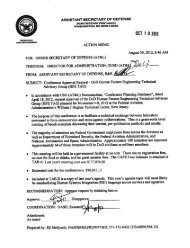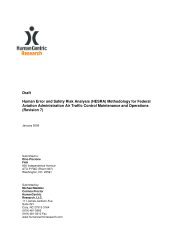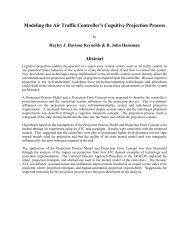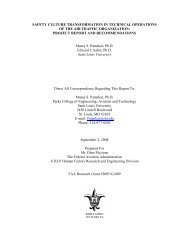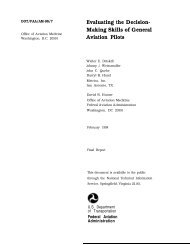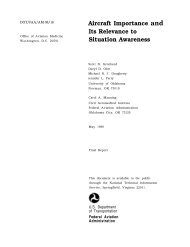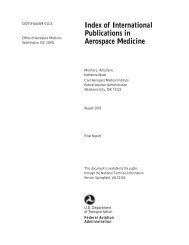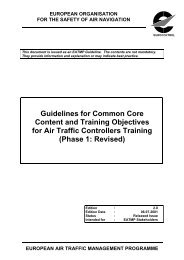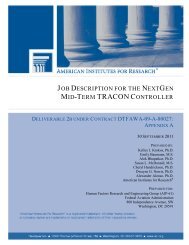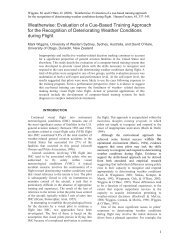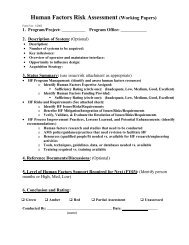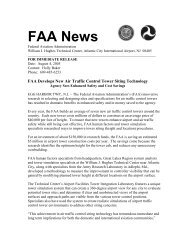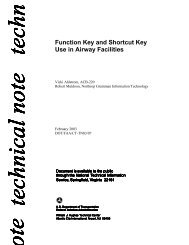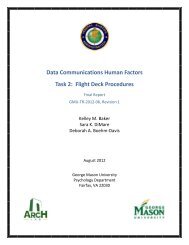job description for the nextgen mid-term atct controller - FAA Human ...
job description for the nextgen mid-term atct controller - FAA Human ...
job description for the nextgen mid-term atct controller - FAA Human ...
Create successful ePaper yourself
Turn your PDF publications into a flip-book with our unique Google optimized e-Paper software.
in<strong>for</strong>mal telephone interviews. These interviews allowed AIR to ga<strong>the</strong>r <strong>the</strong> in<strong>for</strong>mation needed<br />
to refine <strong>the</strong> lists. The majority of <strong>the</strong>se in<strong>for</strong>mal communications were conducted with<br />
individuals who participated in <strong>the</strong> focus groups. AIR also ga<strong>the</strong>red input from an AIR team<br />
member who has over 30 years experience in air traffic control, and who is also a human factors<br />
researcher and a pilot.<br />
The edits to <strong>the</strong> <strong>job</strong> Activities, Sub-Activities, and Task lists did not result in substantive changes<br />
to <strong>the</strong> core ATCS <strong>job</strong> responsibilities. However, <strong>the</strong> lists were reorganized to be more logical;<br />
reordered where appropriate to more closely follow <strong>the</strong> temporal sequence of <strong>the</strong> <strong>job</strong>; reworded<br />
to be more consistent with today’s air traffic control culture; and edited to follow <strong>the</strong> proper<br />
<strong>for</strong>mat. The edits to <strong>the</strong> KSAOs and <strong>the</strong> Tools and Equipment were more substantive. The<br />
existing or draft lists were updated to be more consistent with today’s air traffic control work;<br />
sorted into separate files; reorganized to be more logical; and reworded to be clearer. Finally,<br />
AIR checked <strong>for</strong> correspondence between <strong>the</strong> lists. That is, AIR ensured that <strong>the</strong> Knowledges<br />
required to per<strong>for</strong>m Tasks were captured in <strong>the</strong> Knowledges list and <strong>the</strong> Skill needed to per<strong>for</strong>m<br />
<strong>the</strong> Tasks was captured in <strong>the</strong> Skills list. Substantive ef<strong>for</strong>t was made to make <strong>the</strong> lists across<br />
facility type (i.e., Airport Traffic Control Tower [ATCT)], Terminal Radar Approach Control<br />
[TRACON], and Air Route Traffic Control Center [ARTCC]) consistent—but only if <strong>the</strong> actual<br />
Tasks were indeed <strong>the</strong> same across facility type. For example, <strong>the</strong> Tasks associated with<br />
assuming position responsibility are largely <strong>the</strong> same across facility type and were modified to be<br />
more consistent. The final lists of Activities, Sub-Activities, and Tasks; KSAOs; and Tools and<br />
Equipment are available in both Microsoft Excel workbook <strong>for</strong>m (American Institutes <strong>for</strong><br />
Research, 2011a) and as part of a more detailed technical report (American Institutes <strong>for</strong><br />
Research, 2011b).<br />
These newly revised <strong>job</strong> analytic data <strong>for</strong> <strong>the</strong> current <strong>job</strong> ultimately served multiple purposes.<br />
First, <strong>the</strong>se data provided <strong>the</strong> in<strong>for</strong>mation required <strong>for</strong> AIR’s <strong>description</strong> of <strong>the</strong> current <strong>job</strong> in this<br />
report. Second, <strong>the</strong>se data served as <strong>the</strong> baseline against which AIR applied in<strong>for</strong>mation about<br />
<strong>the</strong> NextGen Drivers and o<strong>the</strong>r NextGen in<strong>for</strong>mation, which in turn served as <strong>the</strong> basis <strong>for</strong> AIR’s<br />
evaluation of whe<strong>the</strong>r and how <strong>the</strong> <strong>job</strong> will change by 2018. This approach was taken because<br />
<strong>the</strong> purpose of this strategic <strong>job</strong> analysis is to describe how an existing <strong>job</strong>—<strong>the</strong> ATCS <strong>job</strong>—will<br />
change, ra<strong>the</strong>r than to describe a completely new <strong>job</strong> that does not yet exist.<br />
Review NextGen Documentation<br />
After updating <strong>the</strong> <strong>description</strong> of <strong>the</strong> current <strong>job</strong>, AIR began developing <strong>the</strong> vision <strong>for</strong> <strong>the</strong> <strong>job</strong> as<br />
it will exist in 2018. This substantive research process comprised several steps. First, AIR<br />
reviewed <strong>the</strong> available NextGen documentation, including <strong>the</strong> Federal Aviation Administration’s<br />
(<strong>FAA</strong>) 2009 and 2010 NextGen Concept of Operations; multiple iterations of <strong>the</strong> Operational<br />
Improvements (OIs); <strong>the</strong> <strong>FAA</strong>’s 2009 and 2010 NextGen Implementation Plans; RTCA’s 2009<br />
NextGen Mid-Term Implementation Task Force Report and <strong>the</strong> <strong>FAA</strong>’s response to it; and many<br />
o<strong>the</strong>rs as identified in Appendix C. These documents helped AIR understand <strong>the</strong> <strong>FAA</strong>’s goals<br />
and priorities <strong>for</strong> <strong>the</strong> implementation of NextGen automation systems, <strong>the</strong> benefits associated<br />
with each, and <strong>the</strong> implementation timeline of <strong>the</strong> technologies, automation, and procedures.<br />
Despite <strong>the</strong> in<strong>for</strong>mative nature of <strong>the</strong> NextGen documentation, <strong>the</strong>se documents captured<br />
NextGen at a high level and did not contain <strong>the</strong> detailed in<strong>for</strong>mation needed to build a vision <strong>for</strong><br />
how <strong>the</strong> <strong>job</strong> of <strong>the</strong> ATCS would change. For example, AIR needed in<strong>for</strong>mation about how <strong>the</strong><br />
12



